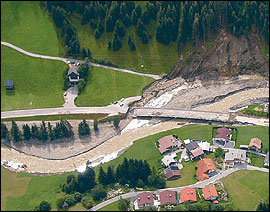 |
Facing the floodsThe Danube River Basin struggled to cope with devastating floods that swept through the region in spring and summer 2005, ravaging communities and causing millions of euros worth of damage. |
 |
The highest ever recorded
discharges on Tyrolean
streams, more than
five-thousand-year water
at the Lech, led to massive
flash floods in Austria. |
"People taken by surprise in the middle of the night sought refuge
on roofs or tree tops, only to find themselves stranded for hours, sometime
for more than 12 hours, waiting in the rain for rescuers who could only
reach those places by boats or helicopters. These were the lucky ones, as
others went into hypothermia from staying too long in cold waters, or found
it impossible to get out of their homes being either too sick, too old,
or having no one around."
Petruta Moisi, Eco Counselling Centre, Galati, Romania
The 2005 floods were driven by extreme meteorological events in parts of
the Danube River Basin. In April, strong rains in the Banat area of Romania,
along with melting snow in the mountain region and soil saturated by water,
led to hundred-year floods in the Timis, Caras and Barzava River Basins,
with the Timis flood also affecting the Serbian territory.
Two more flood waves occurred in Romania in July (in the Arges, Olt, Jiu,
Siret and Prut River Basins) and August (in the Mures, Olt, Somes, Tisza
and Siret River Basins). Torrential rains in a short time resulted in a
huge increase in the discharge of the small rivers (or even dry valleys)
and led to flash floods in the mountain area and thousand-year floods in
downstream river basins.
Heavy rains also fell in Germany, in southern Bavaria
and in Austria, mainly in Vorarlberg and Tyrol. Torrential
rains, for example in Kochel-Einsiedl/Bayern,
where the 24 hour maximum of 217 mm corresponded
to a 200-year probability, along with a reduced surface
retention capacity due to previous rains, led to floods
in south-western Austria and in the Bavarian River
Basins of Iller, Lech, Loisach and Isar. A dramatic
situation arose in Tyrol, where more than two-hundred-year water was observed on the Inn in Innsbruck and more than five-thousand-year
water was estimated
for the Lech at Steeg, Trisanna at Galtur, and Sanna at
Landeck. Massive flash floods resulted from the highest
ever recorded discharges on Tyrolean streams.
Calculating the damage.
In Romania floods in spring
and summer affected about 1.5 million inhabitants.
Altogether 43,900 houses, 4682 bridges and footbridges,
590 social and economic buildings, 10,334 km of
roads and 253 flood protection constructions were damaged
or totally destroyed. More than 12,000 people
were evacuated, and 71 casualties were recorded. In
Serbia, the April flood in Timis flooded two villages
and caused about € 14 million damage to houses and
agricultural production. August floods in the upper
Danube Basin also had severe economic consequences;
the total cost of damages in Bavaria amounted to € 175
million, the preliminary estimate of economic losses in
Austria is € 700 million.
The way out - sustainable flood risk management.
To reduce the impact of floods Romanian authorities took all possible actions
to forecast dangerous situations, to consolidate flood control works (including
raising the dykes along the rivers) and to evacuate residents from affected
areas. But without sufficient retention capacity it was only possible to
reduce the disastrous impacts of flooding.
In Bavaria, no casualties were recorded and the overall flood damage was
lower than after the 1999 floods, thanks to thorough flood protection measures
taken after 1999 as well as efficient reservoir management in the affected
area. This was also due to the integral flood protection strategy implemented
in Bavaria based on natural retention, structural measures and advanced
flood prevention. Results in Bavaria show that the newly built structural
measures saved the old centre of Kempten from flooding despite the 500-year
discharge of the Iller. However, implementing such flood protection strategies
requires substantial financial support: flood protection measures in Bavaria
during 200608 would require a € 150 million annual budget.
This year's floods underlined the urgent need to apply the
major principles of the ICPDR as well as the EU flood risk
management policy: sufficient natural retention of water, allowing
rivers ample space, environmentally friendly structural
measures, integrated river basin management, efficient flood
forecasting and flood warning, and a shift from defensive action
against hazards to management of the risk and living with floods.
THE EUROPEAN FLOOD ALERT SYSTEM
To support efficient and timely flood forecasting
and flood warning the European Flood Alert System
(EFAS) is also being developed by EC JRC in Ispra
for the Danube River Basin. During floods in summer
2005 the EFAS team sent external information
reports to partners in Germany, Slovakia, Hungary
and Austria. The historical discharges at the alpine
streams on August 23, for example, were signalled
by EFAS from August 20 onwards. The performance
of EFAS during these events demonstrated the
benefit of using a combination of deterministic and
probabilistic flood forecasts.
THE GOVERNMENT'S RESPONSE
In reaction to the August floods WWF Austria asked the Austrian Minister
of Environment and Water Protection to prepare a new environmentally friendly
concept of sustainable flood protection since, as WWF stressed, the strategy
of technical flood protection failed. A WWF study showed that in Austria
an additional 840 km2 of space is necessary for rivers and creeks, which
corresponds roughly to 1% of the country's territory. WWF highlighted that
in 2003, while still experiencing the effects of the previous year's floods,
four times as many streams were regulated as revitalised. The only solution
according to WWF Austria is to give rivers more space.
We asked Heinz Stiefelmeyer, a senior flood protection
expert from the Austrian Ministry of Environment and Water Protections about
his position regarding the WWF statement.
He stressed that: